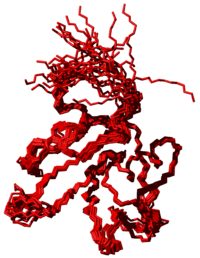Structure calculation with automated NOESY assignment: Difference between revisions
No edit summary |
No edit summary |
||
| Line 4: | Line 4: | ||
;c13.peaks:peak list from 3D <sup>13</sup>C-resolved NOESY spectrum | ;c13.peaks:peak list from 3D <sup>13</sup>C-resolved NOESY spectrum | ||
;n15.peaks:peak list from 3D <sup>15</sup>N-resolved NOESY spectrum | ;n15.peaks:peak list from 3D <sup>15</sup>N-resolved NOESY spectrum | ||
;aro.peaks:peak list from 3D aromatic <sup>13</sup> | ;aro.peaks:peak list from 3D aromatic <sup>13</sup>C-resolved NOESY spectrum | ||
;demo.prot:<sup>1</sup>H, <sup>13</sup>C, and <sup>15</sup>N chemical shift list | ;demo.prot:<sup>1</sup>H, <sup>13</sup>C, and <sup>15</sup>N chemical shift list | ||
;demo.aco:dihedral angle restraints | ;demo.aco:dihedral angle restraints | ||
Revision as of 12:56, 15 July 2009
This calculation shows how to calculate a structure from previously unassigned NOESY peak lists. The input data are in the subdirectory ‘auto’ of the demo data zip archive:
- demo.seq
- amino acid sequence
- c13.peaks
- peak list from 3D 13C-resolved NOESY spectrum
- n15.peaks
- peak list from 3D 15N-resolved NOESY spectrum
- aro.peaks
- peak list from 3D aromatic 13C-resolved NOESY spectrum
- demo.prot
- 1H, 13C, and 15N chemical shift list
- demo.aco
- dihedral angle restraints
- init.cya
- initialization macro
- AUTO.cya
- macro for the structure calculation
Combined automated NOESY cross peak assignment and structure calculation are performed with the macro file AUTO.cya:
peaks := c13.peaks,n15.peaks,aro.peaks # NOESY peak lists in XEASY format #peaks := c13.xpk,n15.xpk,aro.xpk # alternative peak lists in NMRView format prot := demo.prot # names of chemical shift lists restraints := demo.aco # additional (non-NOE) restraints tolerance := 0.040,0.030,0.45 # shift tolerances: H, H', C/N', C/N #calibration_constant:=6.7E5,8.2E5,8.0E4 # calibration constants, automatic if empty structures := 100,20 # number of initial, final structures steps := 10000 # number of torsion angle dynamics steps randomseed := 434726 # random number generator seed noeassign peaks=$peaks prot=$prot autoaco # perform NOESY assignment/structure calculation
First several variables are set: The variable peaks gives the names of the input peak lists, separated by commas without intervening blanks. The variable prot gives the name(s) of the input chemical shift list(s). If a single name is given as in the example, it specifies that a single chemical shift list file with this name will be used for all peak lists. Alternatively, it is possible to specify a separate chemical shift list for each peak list as a comma-separated list of file names. The variable restraints specifies the names of input files with additional conformational restraints that will be used together with the upper distance bounds that will be derived from the NOESY peaks. If there are several file names, they must be separated by commas without intervening blanks. The variable tolerance specifies the tolerances for the matching of chemical shifts, and is used only for the consistency check. The calibration constants for the peak lists can be given by the variable calibration as a comma-separated list of values in the order of the peak list names given by the variable peaks. If the variable calibration is not given, the calibration parameters are determined automatically such that the median of the upper distance limits for each peak list equals the value of the variable dref. The variable dref can have a single value that applies to all peak lists, or separate values for each peak list. This variable is not used when the calibration constants are given explicitly by the variable calibration_constant.
Finally, the sequence and the conformational restraints are read and 100 conformers are calculated using the standard simulated annealing schedule with 10000 torsion angle dynamics steps per conformer. Finally, the 20 conformers with the lowest final target function values are analyzed. An overview table of these 20 best conformers is saved in the file demo.ovw, and their coordinates are written to the PDB file demo.pdb.
